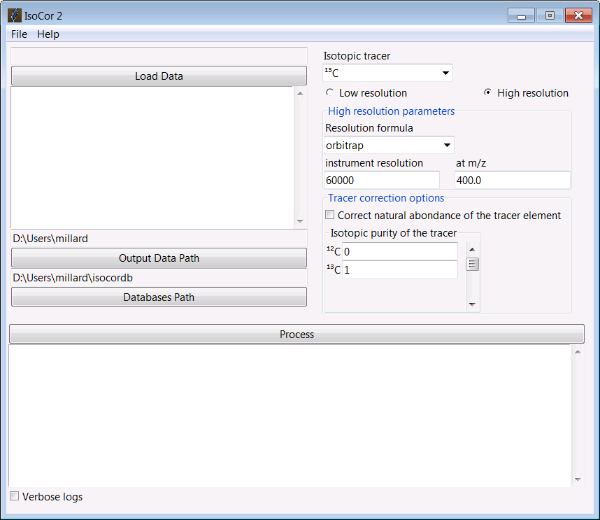Isotope Correction of mass spectrometry data in isotope labeling experiments.
IsoCor corrects raw MS data (mass fractions) for naturally-occurring isotopes of all elements and purity of the isotopic tracer. The output of IsoCor is the isotopologue distribution of the molecule (i.e. the relative fractions of molecular entities differing only in the number of isotopic substitutions of the tracer). IsoCor also calculates the mean enrichment (i.e. the mean isotopic content in the molecule) in metabolites.
It is one of the routine tools that we use at the MetaSys team and MetaToul platform in isotopic studies of metabolic systems.
The code is open-source, and available under a GPLv3 license.
Detailed documentation can be found online at Read the Docs (https://isocor.readthedocs.io/).
- correction of naturally occuring isotopes, both for non-tracer and tracer elements,
- correction of tracer purity,
- shipped as a library with both a graphical and command line interface,
- mass-spectrometer and resolution agnostic,
- can be used with any tracer element (having two or more isotopes)
- account for the contribution of derivatization steps (if any),
- open-source, free and easy to install everywhere where Python 3 and pip run,
- biologist-friendly.
We strongly encourage you to read the Tutorials before using IsoCor.
IsoCor was tested on Windows, Unix and MacOS platforms.
IsoCor requires Python 3.5 or higher. If you do not have a Python environment configured on your computer, we recommend that you follow the instructions from Anaconda.
Then, open a terminal (e.g. run Anaconda Prompt if you have installed Anaconda) and type:
pip install isocorYou are now ready to start IsoCor.
Extensive details on IsoCor usage are provided in the online documentation.
To start the Graphical User Interface, type in a terminal:
isocorThe IsoCor window will open.
Select the measurements file, modify the correction parameters (isotopic tracer, resolution, etc) according to your experiment, and click on 'Process'. IsoCor proceeds automatically to the corrections and display its progress and important messages.
The output of the calculations (i.e. isotopologue distributions) will be written in a text file along a log file.
Warning: The correction options must be carefully selected to ensure reliable interpretations of labeling data, as detailed in the documentation.
A command line interface is also available to use IsoCor, with the command:
isocorcliType isocorcli --help to get information on command line usage. Details can also be found online at https://isocor.readthedocs.io/.
Contributions are welcome.
Please work on your own branch/fork,
follow PEP8 style guide,
and make sure you pass all the tests before a merge.
In development mode, do a pip install -e /path/to/HRcor to install
locally the development version.
Isotope correction is a complex task and we use unit tests to make sure that critical features are not compromised during development.
You can run all tests by calling
pytest in the shell
at project's root directory. pytest must be installed beforehand.
Dependencies:
- Sphinx
- sphinx-rtd-theme
- napoleon
- nbsphinx
- argparse
Build the HTML documentation with:
cd doc
make htmlThe documentation can be found in /doc/_build/html/index.html.
Build the PDF documentation with (you will need latexmk and associated packages):
cd doc
make latexpdf- Millard, P., et al. IsoCor: correcting MS data in isotope labeling experiments. Bioinformatics 2012;28:1294-1296
- Su, X., et al. Metabolite spectral accuracy on orbitraps. Analytical chemistry 2017;89:5940-5948
- Millard, P., Delepine, B. Guionnet, M., Heuillet, M., Bellvert, F. and Letisse, F. IsoCor: isotope correction for high-resolution MS labeling experiments. Submitted
Baudoin Delepine, Matthieu Guionnet, Pierre Millard
Pierre Millard
